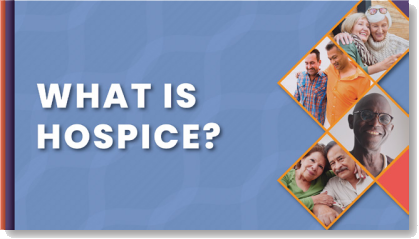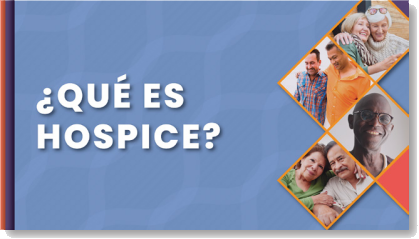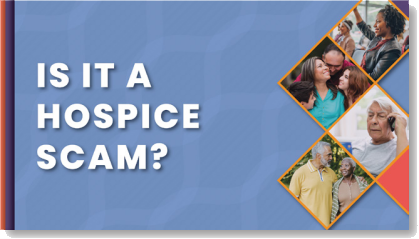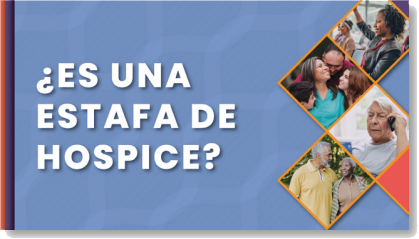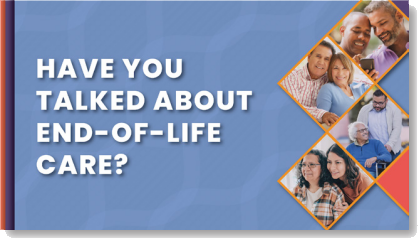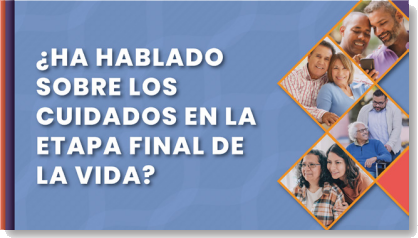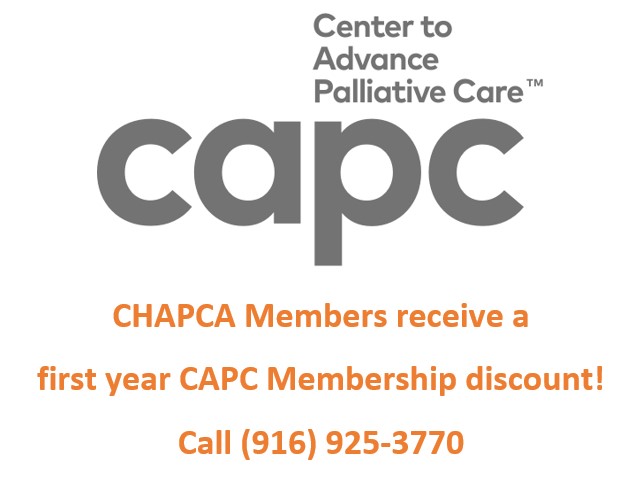- What is Hospice and Palliative Care?
- History of Hospice
- What is Hospice Care?
- What is Palliative Care?
- What is Aid in Dying?
- Don't Wait to Talk about the Care You Would Want
- Caregiving, What’s Your Plan?
- Life Stories Create Memories
- Advance Directives
- Get Your Advance Care Planning Guide
- Choosing a Hospice or Palliative Care Provider
- Grief and Loss
- CHAPCA Resources Library
- Additional Helpful Websites
- Program | Services | Jobs
- Join CHAPCA
- Donate | Advocate | Volunteer
- About Us
- Hospice Fraud Prevention for Consumers
Welcome to the California Hospice and Palliative Care Association's (CHAPCA) Hospice Fraud Prevention and Education page dedicated and designed for consumers.By staying informed, you are taking an active role in helping our most vulnerable population avoid becoming fraud victims.We encourage you to check back often as CHAPCA updates this page with information.Please call CHAPCA at 916-925-3770 or email [email protected] if you think you or a loved one is or has been a victim of hospice fraud or have hospice services and benefit questions.CHAPCA is here to help!
CHAPCA's first Toolkit was designed to support education and outreach to the Hispanic and Latino community regarding hospice and Medicare fraud related to hospice.Diversity, Equity, & Inclusion in Hospice Education and Hospice Fraud Prevention
A Toolkit for Hispanic/Latino Community Outreach HOW TO USE THIS GUIDEThis guide is designed to support education & outreach to the Hispanic/Latino community related to hospice and Medicare fraud related to hospice. It is intended to serve any professional who is in contact with individuals who may be eligible for or looking for information related to hospice. This may include:
PROJECT OVERVIEWThe California Health Advocates (CHA) Senior Medicare Patrol (SMP), in partnership with strategic collaborators California Hospice and Palliative Care Association (CHAPCA) and Inland Caregiver Resource Center (ICRC), led the Diversity, Equity and Inclusion Outreach and Education Project. The goal was to improve resources to help Hispanic/Latino individuals with limited English proficiency (LEP) access accurate and current information about Medicare hospice to help them make informed decisions and avoid becoming victims of Medicare fraud.
THE REASON FOR THIS PROJECTThe California SMP saw a notable increase in hospice fraud complaints during the past year - about 25% of total SMP complex interactions involved deceptive hospice enrollment. This is in comparison to 15% in 2020. An analysis of SMP case data over the past year (2023) shows that the hospice fraud victims who reach out to SMP identify, for the most part, as Hispanic or Latino. Those persons who fall victim to fraud may face dire consequences including lack of access to medications and denial of healthcare services as evidenced by multiple deceptive hospice enrollment cases recorded by the California SMP. The lack of both translated information and personal outreach and education, affects health literacy which can result in a person not making an informed decision, e.g., enrolling in the hospice benefit for which they are not eligible. In addition, in the Master Plan for Aging in California, elder abuse is highlighted as an issue that is being addressed under Goal 3.
Hospice fraud contributes to both financial elder abuse and neglect. Our materials will contribute to awareness and education to decrease this abuse and create a more inclusive and equitable community for older adults. OUR PROCESSWe started our project by compiling a list of questions for listening sessions to understand the current level of knowledge and acceptance of hospice services by Hispanic/Latino caregivers and older adults. The questions are included below as Exhibit A. To encourage participation in the listening sessions, ICRC reached out to current clients, whom they had established relationships with and had built trust. Clients were invited to participate in a very personal manner - letters were sent, direct calls were made. Invites highlighted the importance of their opinions and that they were experts in what they do - providing care for a loved one. They were invited in for a chat. Sample marketing flyers and invitation letters are included here as Exhibit B. Two listening sessions were held. They were faciliated by ICRC staff, a chaplain from the community, and a representative from CHAPCA. ICRC staff led the discussions and, when requested, clarification on the hospice benefit was provided by the chaplain, and notes were taken by the CHAPCA representative. Sessions were held with 15 Spanish speaking participants. During the listening sessions, the facilitators simply listened to the participants, without providing any corrections to their misconceptions. The intention was to hear what they currently believe about the topic of hospice, and to ensure the participants were not made to feel “wrong” for their beliefs. Instead, the focus of the listening groups was to receive information, whether it was correct or incorrect, and use it to inform the materials that were created. Follow up questions were used to get more information or clarification from the participants.
Based on those listening sessions, we began to compile content for marketing and outreach materials. We learned that not only did we need to address Medicare fraud, but there were also many misconceptions about hospice that needed to be addressed. Our content evolved to include basic hospice education as well as tools for caregivers to address conversations about hospice. The intention was to create awareness about hospice care services as well as encourage end of life care discussions. We started by organizing and prioritizing the educational content in English. This allowed us to get all the important information organized into digestible marketing pieces. Then, we went through the process of adapting this material to Spanish - this includes translating the content with thoughtful language as well as adapting the imagery used in the marketing to align with the intended audience. Ultimately, we developed a toolkit of marketing materials in English and Spanish.
OUR FINDINGSBelow is a summary of the listening session findings. Session Info At the start of each session participants were given the opportunity to introduce themselves. They shared about who they cared for, how they began providing care, how long as well as stories about their caregiving experiences thus far. This first question had a lot of discussion and took 30-45 minutes to complete. Facilitators wanted to make sure participants felt comfortable sharing. A light breakfast and lunch were provided. Socialization took place during meals. This created a comfortable, informal environment in which people felt like they were having a conversation over coffee, and connecting with the other participants. The purpose of the session was explained which was to gain their input on Medicare/ Hospice/End of Life Care issues so that we could learn ways to better reach/communicate with the Hispanic/Latino community about said topics.
Finding Out About Hospice Participants shared their experiences with hospice. Some participants shared the person they cared for was on hospice before they passed, another currently had the person they cared for on hospice and others weren’t sure how or when to access the benefit. Those on the service shared they learned about it through their health care provider, but that services weren’t clearly explained. The hospice agency they were working with explained the benefit better. Others shared they learned about it through family/friends who encouraged them to access the benefit. Others were confused about what the benefit was and didn’t know if the services they were receiving were hospice or not. Some participants stated they were participating in the session so they could learn more about it. Collectively the group felt outreach/information for hospice is not accessible and they felt it was important to learn about it sooner rather then later.
Hospice Knowledge As mentioned above, most of the participants had heard about the term hospice and that it had a relation to dying. The ones that had experience with the benefit shared about all the services they received such as equipment, oxygen, medication, supplies, respite, etc. The Chaplain explained that the benefit was available to those who had been diagnosed with a terminal illness and whom doctors said had 6 months or less to live. She also explained who makes up the hospice team (nurses, aides, doctor, social worker, chaplain), the role of a Chaplain, and services available. She stated that hospice focuses on patient care and the quality of life for those who have been given a terminal diagnosis. She also provided education on the importance of finding the right hospice and the unfortunate level of fraud in the community. When asked by participants, information was also provided about how the benefit is paid for and how to find a hospice agency. The Chaplain explained that hospice is a benefit that can be accessed through your healthcare provider or if you feel the person you care for should be on hospice. Hospice agencies can be contacted directly for an evaluation. Some participants did not know it was not an on-going benefit, patients could come off hospice and that the patient’s condition/prognosis has a lot to do with if they qualify and how long they could potentially be on it. Those with experience with hospice had both positive and negative things to share. There were those who stated they had a very good experience with it. Staff was professional, caring, and provided a lot of guidance. Others shared the hospice agency they worked with didn’t provide the supplies needed, were never available, and had a bad attitude. The importance of advocating for one's needs and concerns was discussed as well as the need to be well informed about the benefit to know what to advocate for and how to choose the right hospice agency. The group also stated that good communication is essential.
End of Life Care – Planning The group had a discussion on end of life planning. Participants shared the importance of planning ahead to make things easier. Some felt it is important not only to address things like wills and trusts, but also our emotions so that all things are left in order. This means spirituality and religion should be considered. It’s important for people to be treated the way they want to be treated when they are at their end of life, but first they need to share what they would like so they need to be asked. Participants shared plans they had made with the person they care for as well as their own plans for end of life planning in terms of burials, funerals, services, etc. Others shared negative experiences they had with family members about inheritances and decisions about health care for people that passed. One member stated that a lot of times people don’t want to talk about end of life plans because then it's like accepting death is here or is coming and they don’t want to talk or think about death. He also emphasized death is part of life and we need to change the way we speak/view/approach death in the Hispanic/Latino culture so that it stops being a taboo. Another member stated she shares more on the subject now and others are also sharing. When she shares it helps others open up about the subject and feel more comfortable. The group agreed it is important to plan to avoid conflict and so everyone is more at peace, but this is a sensitive topic.
End of Life Care – Traditions End of life traditions were shared and discussed. Participants spoke of their customs and religions and how they impacted death. These included prayer, mass, funerals, viewings, novenarios (offerings and prayers for the dead made during the nine days after death), clothes, and specific requests by loved ones. One member discussed the need to teach our family early on so that we aren’t so afraid to talk about it or the plans we want followed. He shared that we should start new traditions that include learning about death at a young age. This will make us better prepared when death comes and we will see it as part of life. If we do, we will share memories instead of whispering about death like we shouldn't talk about it. Having a good quality of life should be the goal when we speak of end of life not fear. Another member expressed the importance of community when someone passes especially if there are financial hardships involved. Others spoke about expressing the right messages to those who have lost someone and being genuine and present. Participants had varying views on traditions and how they should be followed, but agreed that these topics are personal to everyone and must be respected.
End of Life Care – Quality of Life The importance of having a good quality of life was discussed at various points during both sessions. This included being well informed about the diagnoses of the person you are caring for so that planning for end of life care and preparing for it was easier. There were complaints about doctors not informing them well and not being empathetic or patient centered. This made caring for someone very difficult and oftentimes they felt left in the dark. Many shared they have learned more about how to provide care and diagnosis through ICRC. They expressed gratitude for being considered when it comes to the care they provide and also expressed the importance of sharing valuable resources. The group shared their thoughts about what a good quality of life meant. To some it meant not having pain, being at peace, being properly cared for (fed, changed, etc.), quality time, planning, and sharing memories. Some suggested training professionals on end of life care and good quality of life so they could be more empathic and communicative about services such as hospice.
Outreach to the Hispanic/Latino Community The groups had rich discussions about how they prefer to be reached about services and also shared ideas about how to reach the Hispanic/Latino Community. Everyone agreed that language was extremely important. This means there should be proper translation of words. Preferably completed by a native speaker and not google. They shared they like to receive information via fliers, radio, TV, at churches, grocery stores, “meetings like these”, waiting rooms, doctors’ offices, health fairs, swap meets (flea markets), farmers markets, social media platforms (Facebook, Tiktok, Instagram), consulates, libraries, IHSS, social clubs, dances, and Hispanic/Latino press. There was consensus that professionals need to be trained on resources and how to interact with different cultures because “our roots have shaped us and how we respond”. One member mentioned the need for the Hispanic/Latino community to learn how the “system” works because many fear it because they don’t trust it. Participants also shared specific radio stations/channels to share information on. The group also expressed the need to share and spread the word, “Corre la voz”. The more you share the more people become interested and comfortable with topics like end of life care, benefits, planning, services etc. RESULTSBased on the listening sessions and our research, we decided to create the following marketing assets in English and Spanish:
MARKETING ASSETS (LINKS)All assets include 3 resources and context on which audience they are intended for, depending on the person’s current situation. 3 Page Flyer
1 Page Flyer
Video
Radio
KEY TERM FOR OUTREACH IN SPANISH - HOSPICEDetermining how to talk about “hospice” in Spanish was critical to this project. There is not one word that translates perfectly from English to Spanish - to accurately capture the meaning, you have to explain the concept. There is not a literal translation that captures the same meaning. In our listening sessions, when asked what they thought about when they heard the word “hospice” participants used the following words: Chills, death, terminal, last days, acceptance. There were great discussions about the term and what it represents. Misconceptions arose as some participants thought placing someone on hospice meant taking them somewhere. Others shared their frustration with the misinformation about the service and how professionals don’t know enough about it to communicate the right information with them. Collectively they all knew hospice was related to dying.
We also referenced AARP and Family Caregiver Alliance to see what other professional authorities use in their Spanish content. Both organizations use a correct translation of “cuidados de hospicio'' but but these are not the terms often used by providers or recognized in the Hispanic/Latino community. There are a lot of terms being used in translated hospice materials - hospicio, servicios de hospicio, cuidados de hospicio, cuidados paliativos, cuidados de enfermos terminales. Some of these translations completely remove the connection to the word hospice. While “cuidados de hospicio” or a similar variation is the consensus on the best term to use, is it the way it is actually being presented by the people who are committing the fraud? Many of the fraudulent providers do not have any easily accessible materials or marketing in Spanish - in fact, a lot of the agencies are not addressing the Spanish speaking community at all. Part of the reason the fraud can be committed is because there is a lack of consistency and education related to the terms used.
We want to build a recognition of the word hospice and help them to understand the context of hospice care so they have a better understanding of how these services are connected and are more equipped to identify potential fraud.
HOW WE ARE GOING TO USE THESE TOOLS
Staff Training ICRC will be conducting agency-wide training, utilizing the toolkit to ensure staff understand what the hospice benefit is as well as the fraud that is going on in the community. Additionally, ICRC will conduct in-depth training about the tools with Education & Outreach staff, Intake Specialists, Care Coordinators and Family Consultants to ensure they are equipped to educate clients about hospice, answer questions related to hospice, and point clients to the appropriate resources for additional support. Training will be done annually and will include updates to the hospice benefit and toolkit, if there are any.
Sharing with other Professionals CHAPCA will be reaching out to senior centers throughout the state, managed care plans, state and federal agencies to offer training about how to utilize the tool kit. ICRC’s clinical and outreach staff will share the information to the over 40 collaboratives it participates in each month which are composed of social service providers in the Inland Empire. One of these collaboratives is the Inland Coalition on Aging (ICA) who brings together diverse health care entities, community based organizations, public officials, and stakeholders with the goal of better serving older adults, adults with disabilities, and caregivers in San Bernardino and Riverside Counties. The ICA is currently working on the development of a local Inland Empire Master Plan for Aging (IE-MPA). As a coalition member, ICRC will share the toolkit with the Inland Empire Master Plan for Aging Advisory Committee to see how it can align with the the IE-MPA. In listening sessions, participants expressed that the professionals they interacted with did not have comprehensive information about hospice. We hope that by sharing this toolkit, more professionals are educated and able to speak to the hospice services & potential hospice fraud in the community.
Legislative Advocacy CHAPCA will use the tool kit to distribute to California lawmakers (state and federal) as a resource for them to use internally to inform themselves as well as a resource for their constituents. When developing this tool kit, CHAPCA reached out to a hospice pioneer for guidance. That pioneer is Judi Lund Person. Judi was on the capitol steps as a founder of the hospice benefit. Judi is still actively involved in hospice as an advocate for beneficiaries and access to quality hospice care. When asked to look at the tool kit and its use as a tool for advocacy with lawmakers, Judi shared:
Digital Marketing Outreach Assets created will be shared on the website and social media accounts of the participating organizations. ICRC will also include information in English and Spanish throughout the year in its monthly digital newsletter, during Facebook Lives, and in the monthly educational workshops it facilitates virtually. The intention of sharing these assets is to build public awareness & encourage conversations about these topics.
Sharing with the Community As referenced in our listening sessions findings, there was a rich discussion about how the community would like to be informed about these topics. Ideas included information available on fliers, radio, TV, at churches, grocery stores, waiting rooms, doctors’ offices, health fairs, swap meets (flea markets), farmers markets, social media platforms (Facebook, Tiktok, Instagram), consulates, libraries, IHSS, social clubs, dances, and Hispanic press. This helped to inform the assets that we created and how we will disseminate them in the community. Participants also expressed the need to share and spread the word, “Corre la voz”. We intentionally created simple, easy to share marketing pieces so that people are able to easily share them with family, friends and their community. We also learned that willingness to receive and accept information has a lot to do with trust. Participants want to trust the organization or person who they are hearing this information from. As a trusted non-profit organization in the community who has been in existence since 1985, ICRC will disseminate the marketing assets in the outreach it conducts throughout the community in the ways referenced above as requested by participants in the listening sessions.
CONCLUSIONThank you for utilizing this toolkit to inform and educate your community about hospice and hospice fraud. A heartfelt thank you to the ICRC clients that participated in the listening sessions for sharing their insights and personal experiences.
If you have any questions about this toolkit, please reach out to: California Hospice and Palliative Care Association at: 916-925-3770 or [email protected] Inland Caregiver Resource Center at: 800-675-6694 or [email protected] California Senior Medicare Patrol at: 855-613-7080 or [email protected] |
|||||||||||||||||||||||||||||||||||||||||||||||||||||




